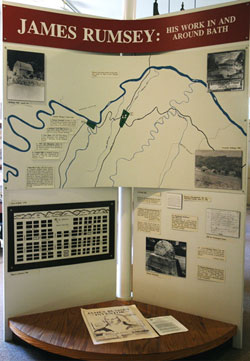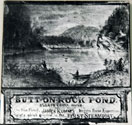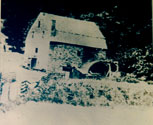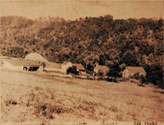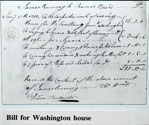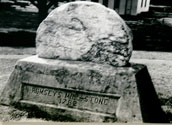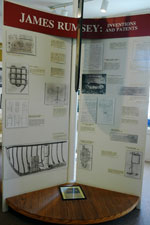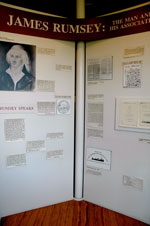|
Panels 1 and 2 James Rumsey: His Work in and Around Bath (Click on images to view enlargements ) What is now Morgan County, West Virginia began as part of Lord Fairfax’s extensive landholdings in America. The area began as part of Frederick County, Virginia. In 1772, this area was included as part of the newly formed Berkeley County, Virginia. Morgan County was formed in 1820 from sections of adjacent Berkeley and Hampshire Counties. In 1863, Morgan County joined the newly formed state of West Virginia. Town of Bath: Once white settlers began visiting the Springs in the late 1740s there was a settlement around them called by varying names including Warm Springs, Medicinal Springs and Frederick Springs. The name Bath was given in December 1776 when Virginia chartered a town on 50 acres around the springs. It is still the official name of the town although most know it by the Post Office name of Berkeley Springs assigned in 1801. Fourteen men, including Samuel Washington (brother of George) and Reverend Charles Mynn Thurston, were appointed trustees by the Virginia General Assembly and assigned to lay off streets and lots and record them for sale when in the October 1776 legislative session, the Town of Bath was incorporated. After several months of advertising, the lots were sold at public auction in 1777. The plat shown in the exhibit is based on the original layout of the town although it was redrawn in 1798. The Town of Bath limits remain much the same today. There are two walking tour brochures available at the Museum. One was prepared by the Bicentennial Commission 1976 and lists all the original lot owners and history of selected lots. Plaques keyed to the Walking Tour are placed at the lots. In 2004, a walking tour was created that details the history of every lot in the town’s center core The town lots in which Rumsey had an interest or was involved are identified on the map shown here and in the Museum exhibit. The accompanying legend details information about the lots. 1. Rumsey sawmill: The Museum has a copy of the Deed Book pages that list Rumsey’s purchase of this 109 acre tract along Sleepy Creek just downstream from a rock formation known as Butt-on Rock. Currently the land is in private hands. Remnants of a stone foundation believed to be Rumsey’s house, and a long mill race can still be seen.
The illustration is reproduced from a glass negative made by John Moray and donated to the West Virginia University Library regional collection by local historian Fred T. Newbraugh. The original sketch which is photographed was made by Moray, an artist and amateur historian who lived and worked in Berkeley Springs at the turn of the 20th century. He became a Rumsey enthusiast. Butt-on Rock remains virtually unchanged from this picture. 2. Bedinger Grist Mill: George Michael Bedinger, an early Rumsey associate, went to Kentucky soon after the mill was built although he eventually returned. More can be learned about Bedinger from his biography: George Michael Bedinger, a Kentucky Pioneer by Danske Dandridge. A grist mill is used to grind flour.
The mill was razed on August 11, 1911 according to a diary of C. C. Ailes, a horticulture student working at Mr. Fulton’s orchards during that summer. Ailes writes: “Went with a force of men to the upper place where we tore down an old mill – the work almost played me out as the day was so hot – 108 degrees.” The diary was in the collection of Mr. Newbraugh.
The property is currently owned by Morgan Management Inc, used as their headquarters and available for sale as lots. 3. Iron Mine: Local tradition claims that James Rumsey mined iron ore on Sleepy Creek Mountain near the Meadow Branch, melted this ore in his bloomery, and used the finished iron to make parts for his mills. There is no period documentation to support this claim. 4. Mill and Bloomery: A bloomery is used to smelt iron ore. The site of these buildings remains today on the west bank of the Meadow Branch just to the west of Spruce Pine Hollow Park. The land is owned by the Sons of the American Revolution. A segment of the Tuscarora Trail, a feeder to the Appalachian Trail transits the area and has a few primitive campsites there. Spruce Pine Hollow Park is along WV9 several miles east of Berkeley Springs, and is a site on the Washington Heritage Trail National Scenic Byway. Remains at the site include stone ruins of the probable mill building and a long, man-made flume to bring water from the Meadow Branch down to Rumsey’s mill. In Rumsey’s time, the land was owned by his brother Edward Rumsey. A millrace powers a mill or bloomery by bringing water to turn the wheel that generates power to operate the machinery. How water hits a mill wheel had significant bearing on how much power was generated. Rumsey had many significant inventions in later years based on making more efficient the power generation process of mills. He also patented a hydrostatic bellows (bloomery equipment) in London and the United States. 5. Colston Mill: The site of this mill is reported to be along Warm Springs Run near the present Morgan County Board of Education building on Harrison Ave. Information describing the mill is contained in a 19th century lawsuit noted by Fred T Newbraugh. The improvements in mill machinery that allowed for this mill to be built on a stream not previously considered adequate were early examples of what became a major field of inventive endeavor for Rumsey.
Orrick was also a partner of James Rumsey in a merchantile establishment in the Town of Bath. Orrick participated in Rumsey’s steamboat experiments in the area. His statement supporting Rumsey’s claims in this work was included in Rumsey’s Steam pamphlets. (See pamphlet on display in exhibit.) Orrick stated that he had been a passenger on the steamboat during Rumsey’s early trials. In a Joseph Barnes pamphlet supporting Rumsey’s claims to inventing the steamboat (May 1788) Nicholas Orrick is quoted as saying: “…having occasion of boarding with Mr. James Rumsey in the month of January, year of Our Lord 1785 where amongst many of his various experiments, one I remember very particularly.” Orrick describes the water tube boiler Rumsey invented. He then asked Rumsey what this invention was for…” by that principle he would make the boat go, and after some small matter of conversation, he took his pen and ink, and retired to make his calculations as was his custom after experiments made, many of which he made during the winter.” (See water tube boiler drawing on Inventions panel. Rumsey claimed in his pamphlet announcing this invention that it was done “in the winter of 1785”.) 7. Boat Site: Descriptions of this first boat building are included in Rumsey’s Steam pamphlets – 1788. (See pamphlet on display in this exhibit. ??Text of pamphlet is posted on this site.??) June 27, 1938, local historian Anita Buchanan Speers christened this spot on the Potomac where Sir Johns Run enters, Port James Rumsey. It is a site on the Washington Heritage Trail. This event climaxed Mrs. Speer’s successful effort to win recognition for Rumsey’s inventive genius. The full text of Rumsey’s grant from the Continental Congress that started the boat building here is included in the Museum’s Rumsey file. In his deposition included in Rumsey’s 1788 Steam pamphlet, Rumsey’s brother-in-law, Charles Morrow describes Barnes as Rumsey’s “principal mechanic…employed by Mr. James Rumsey in May 1785, to build a boat on the Potomac River near the Town of Bath.” Morrow further said that Barnes “has received from said Mr. Rumsey five pounds per month besides his board from April 1785 to the present.” (Dec. 1787) In Barnes’ deposition in this same pamphlet, he describes his five-pound a month wage as a small part of Rumsey’s expense in building this steamboat. Once the boat was brought to Shepherdstown, a series of mishaps with boat, engines, and weather postponed a successful public trial until Dec. 3, 1787.
There is no period documentation of Rumsey’s role in the Inn beyond that of co-owner. In Travels of a Frenchman, a young visitor, Ferdinand M. Bayard, writes of his visit in the summer of 1791 to the Throgmorton Inn: “We gave three gourds (some 16 pounds) a week to Mrs. Throkmorton, relative of General Washington. This good American woman, because of her freedom from self-interest, which is unusual among people who run boarding houses, managed her business rather badly.” “Madame Throkmorton had about forty boarders, whom she fed well.” Later Bayard once again describes Mrs. Throkmorton as “sweet and trustful, and inspired only by kindness” but a poor businesswoman and in financial trouble. Throgmorton Inn ad. This advertisement was photocopied from an existing copy of the Maryland Gazette. Fort New Salem, West Virginia, ran off a complimentary copy of the ad on an 18th century press making the exhibit illustration a replica of the original advertisement. 9. Rumsey Pole Boat Demonstration: There is no period documentation of the exact location of Rumsey’s demonstration to Washington in Bath on Sept. 6, 1784. Washington only says in his diary entry “the water, which had been made to run pretty swift…” Since it is known that Washington stayed at this time at the Throgmorton Inn where Rumsey was a partner, it can be assumed that Rumsey may have used the stretch of the Warm Springs Run directly behind the Inn (See Lot #26 on Town map) for; the demonstration. Washington states in his diary that Rumsey wanted the demonstration kept secret, which argues against choosing a spot along the run in the park for his demonstration. The description of the pole boat model is taken from Rumsey’s 1788 Steam pamphlet. A later version of the pole boat was patented by Rumsey in England (See exhibit section on Inventions & Patents). It is this pole boat that Rumsey patented in Maryland and Virginia later in 1784. Although 19th century Rumsey biographers sometimes claimed this was a “steamboat” model that Rumsey showed Washington, echoing steamboat rival John Fitch’s 18th century attack on Rumsey claiming that he dishonestly stated that he showed Washington a steam boar, it is clear from both Washington and Rumsey letters and pamphlets that the pole boat had no steam components. John Fitch solicited a certification from an Edward Pennington who on Oct 11, 1787 swore that he too had seen Rumsey demonstrate a model boat at Bath in September 1784 and “that there was not any steam engine to work said boat, not did I ever hear the said James Rumsey mention anything about a boat being worked by means of steam.” A more complete description of the events of this fateful day for Rumsey is obtained in an address made to Museum Trustees at the September 6 Celebration, 1985, written by Jeanne Mozier and published in the December 1985 issue of the Jefferson County Historical Society Magazine. A copy is available in the Museum’s Rumsey file, and available for purchase. 10. Washington Buildings: George Washington was an original lot owner in the Town of Bath. He owned lots # 58 & 59. The same day he saw Rumsey’s model boat demonstration, he contracted with Rumsey to build a house, described in Washington’s Diary entry for that day. (See Washington writings on www.berkeleysprings.com.) For the next two years, a series of letters were exchanged by Washington and Rumsey on the subject of these buildings. In early 1785, Washington told Rumsey he could not afford to build more than the kitchen and stables immediately. Rumsey had already started on the big house however. Then in April 1785, tragedy struck. Rumsey’s mill burned destroying the lumber for Washington’s house and Rumsey’s boat. (See Washington writings on www.berkeleysprings.com.) In August 1786, at Washington’s request, his friend George Lewis examined the buildings Rumsey had constructed. Lewis wrote Washington a detailed description summarizing: “the houses are esteem’d badly built and of bad timber.” The buildings Lewis describes are two: a stable for four, and another with a chimney. Washington’s ledger books claim that Rumsey was paid 73 pounds for his work. In 1794, Washington claims that buildings on his lots in Bath cost him 150 pounds. In Vol 3 of Warm Springs Echoes, local historian Fred Newbraugh shows a picture of Colonel Dole standing in front of a house on the Washington lots soon to be razed – 1869. This house does not fit the Lewis description above of the buildings constructed by Rumsey for Washington. It is not known when the house razed by Dole was built. Dole’s house was in turn razed in the mid-20th century to be replaced by the current contemporary structure, which is a site on the Washington Heritage Trail. Bill for Washington House: Thomas Beard was an Alexandria merchant. Rumsey and Washington exchanged a series of letters during 1785 detailing their financial dealings over Washington’s buildings. Washington’s ledger books claim that Rumsey was paid a total of 73 pounds for his construction work. The original of this bill is found in the Rumsey Papers in the Manuscript Collection of the Library of Congress. 11. Orrick-Rumsey Store: This description of the Orrick-Rumsey relationship was made by Orrick in 1816 as part of an effort made to the US Congress to gain some financial grant for Rumsey’s children. For more information about Orrick see the entry for Orrick Mill (#6). Orrick purchased Lot #97 from its original owner: William Weather, Berkeley County blacksmith. This site has been a retail business since the current building was constructed in 1962.
click on image to view each section of manual
|

